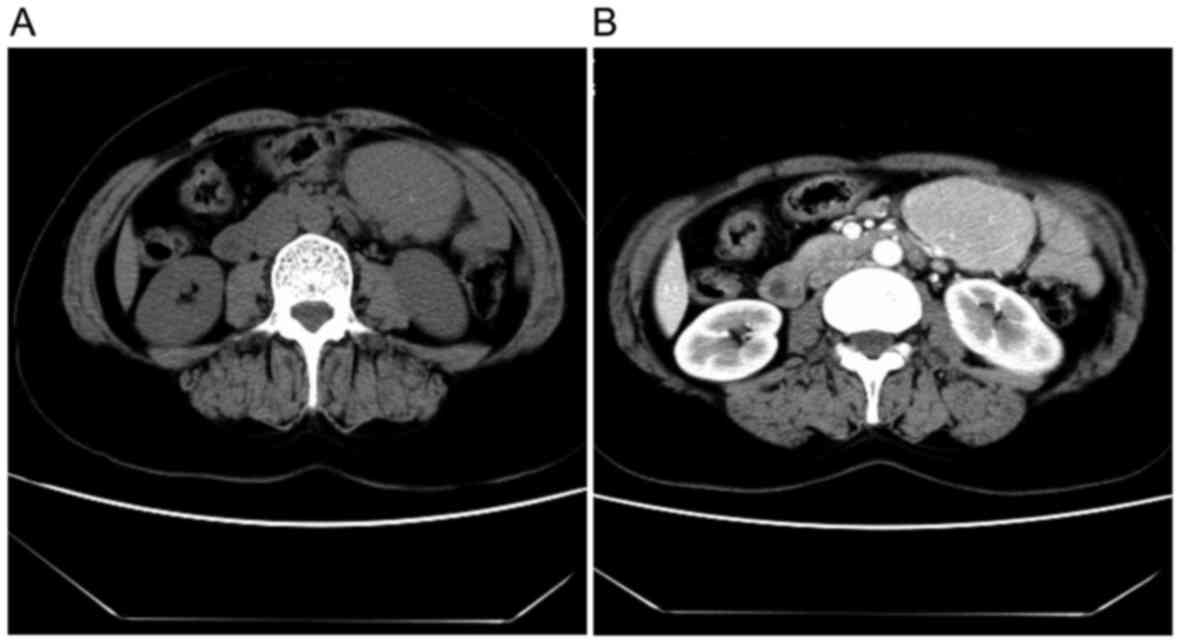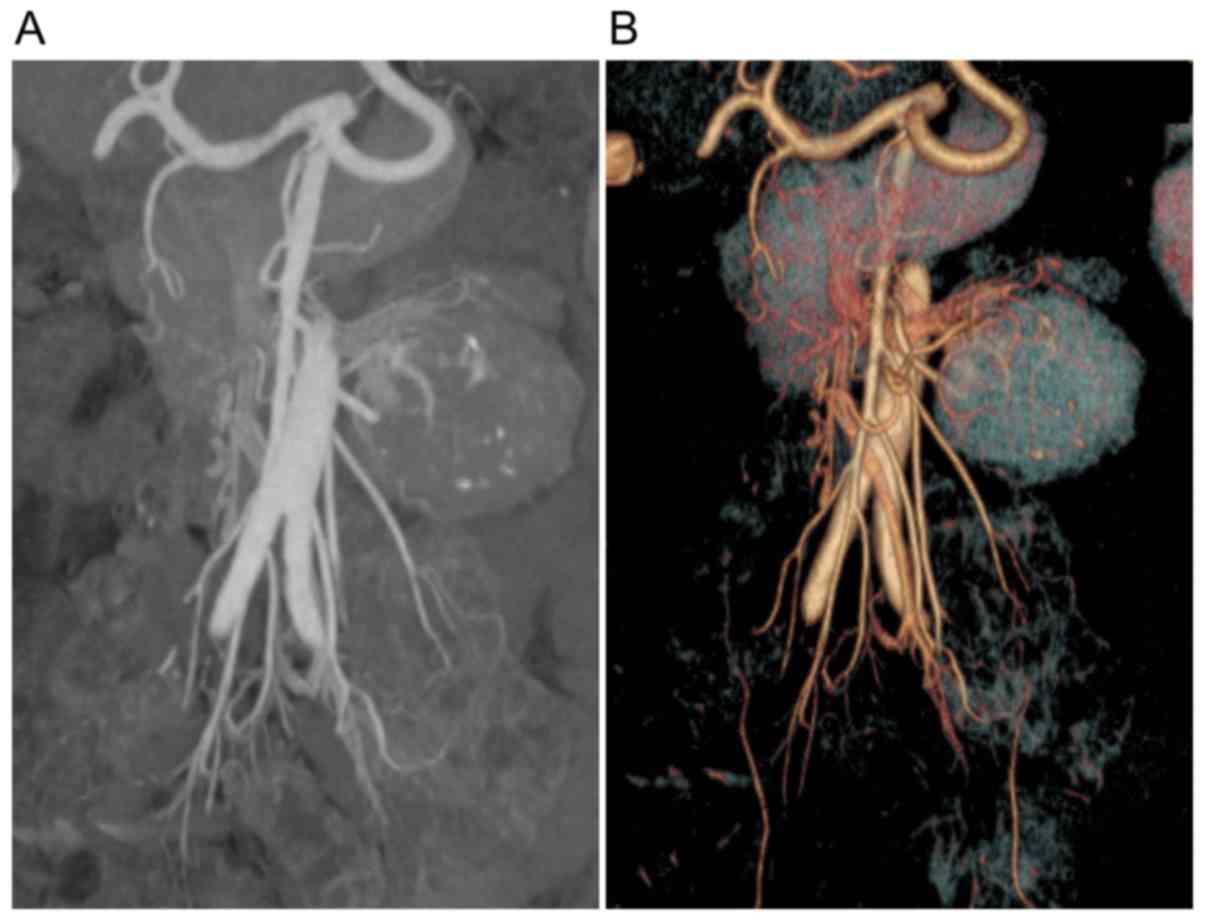|
1
|
Castleman B and Towne VW: Case records of
the Massachusetts general hospital; weekly clinicopathological
exercises; founded by Richard C. Cabot. N Engl J Med. 251:396–400.
1954.PubMed/NCBI
|
|
2
|
El-Osta HE and Kurzrock R: Castleman's
disease: From basic mechanisms to molecular therapeutics.
Oncologist. 16:497–511. 2011. View Article : Google Scholar : PubMed/NCBI
|
|
3
|
Waterston A and Bower M: Fifty years of
multicentric Castleman's disease. Acta Oncol. 43:698–704. 2004.
View Article : Google Scholar : PubMed/NCBI
|
|
4
|
Keller AR, Hochholzer L and Castleman B:
Hyaline-vascular and plasma-cell types of giant lymph node
hyperplasia of the mediastinum and other locations. Cancer.
29:670–683. 1972. View Article : Google Scholar : PubMed/NCBI
|
|
5
|
Casper C: The aetiology and management of
Castleman disease at 50 years: Translating pathophysiology to
patient care. Br J Haematol. 129:3–17. 2005. View Article : Google Scholar : PubMed/NCBI
|
|
6
|
Yoshizaki K, Matsuda T, Nishimoto N,
Kuritani T, Taeho L, Aozasa K, Nakahata T, Kawai H, Tagoh H, Komori
T, et al: Pathogenic significance of interleukin-6 (IL-6/BSF-2) in
Castleman's disease. Blood. 74:1360–1367. 1989.PubMed/NCBI
|
|
7
|
Vinzio S, Ciarloni L, Schlienger JL, Rohr
S, Méchine A and Goichot B: Isolated microcytic anemia disclosing a
unicentric Castleman disease: The interleukin-6/hepcidin pathway?
Eur J Intern Med. 19:367–369. 2008. View Article : Google Scholar : PubMed/NCBI
|
|
8
|
Reddy D and Mitsuyasu R: HIV-associated
multicentric Castleman disease. Curr Opin Oncol. 23:475–481. 2011.
View Article : Google Scholar : PubMed/NCBI
|
|
9
|
Shen XF, Guan WX, Cao K, Wang H and Du JF:
Small bowel volvulus with jejunal diverticulum: Primary or
secondary? World J Gastroenterol. 21:10480–10484. 2015. View Article : Google Scholar : PubMed/NCBI
|
|
10
|
Dispenzieri A: Castleman disease. Cancer
Treat Res. 142:293–330. 2008.PubMed/NCBI
|
|
11
|
Műzes G, Sipos F, Csomor J and Sréter L:
Multicentric Castleman's disease: A challenging diagnosis. Pathol
Oncol Res. 19:345–351. 2013. View Article : Google Scholar : PubMed/NCBI
|
|
12
|
Herrada J, Cabanillas F, Rice L, Manning J
and Pugh W: The clinical behavior of localized and multicentric
Castleman disease. Ann Intern Med. 128:657–662. 1998. View Article : Google Scholar : PubMed/NCBI
|
|
13
|
Bonekamp D, Horton KM, Hruban RH and
Fishman EK: Castleman disease: The great mimic. Radiographics.
31:1793–1807. 2011. View Article : Google Scholar : PubMed/NCBI
|
|
14
|
Frizzera G: Castleman's disease and
related disorders. Semin Diagn Pathol. 5:346–364. 1988.PubMed/NCBI
|
|
15
|
Talat N, Belgaumkar AP and Schulte KM:
Surgery in Castleman's disease: A systematic review of 404
published cases. Ann Surg. 255:677–684. 2012. View Article : Google Scholar : PubMed/NCBI
|
|
16
|
Barker R, Kazmi F, Stebbing J, Ngan S,
Chinn R, Nelson M, O'Doherty M and Bower M: FDG-PET/CT imaging in
the management of HIV-associated multicentric Castleman's disease.
Eur J Nucl Med Mol Imaging. 36:648–652. 2009. View Article : Google Scholar : PubMed/NCBI
|
|
17
|
Ye B, Gao SG, Li W, Yang LH, Zhao SH, Ma
K, Zhu XL, Liu XY and Sun KL: A retrospective study of unicentric
and multicentric Castleman's disease: A report of 52 patients. Med
Oncol. 27:1171–1178. 2010. View Article : Google Scholar : PubMed/NCBI
|
|
18
|
Meador TL and McLarney JK: CT features of
Castleman disease of the abdomen and pelvis. AJR Am J Roentgenol.
175:115–118. 2000. View Article : Google Scholar : PubMed/NCBI
|
|
19
|
Mangini M, Aiani L, Bertolotti E,
Imperatori A, Rotolo N, Paddeu A, Uccella S, Carrafiello G and
Fugazzola C: Parapancreatic Castleman disease: Contrast-enhanced
sonography and CT features. J Clin Ultrasound. 35:207–211. 2007.
View Article : Google Scholar : PubMed/NCBI
|
|
20
|
Noh OK, Lee SW, Lee JW, Kim SY, Kim CS,
Choi EK, Kim JH and Ahn SD: Cases report of unicentric Castleman's
disease: Revisit of radiotherapy role. Radiat Oncol J. 31:48–54.
2013. View Article : Google Scholar : PubMed/NCBI
|
|
21
|
Frizzera G, Banks PM, Massarelli G and
Rosai J: A systemic lymphoproliferative disorder with morphologic
features of Castleman's disease. Pathological findings in 15
patients. Am J Surg Pathol. 7:211–231. 1983. View Article : Google Scholar : PubMed/NCBI
|
|
22
|
Lee HJ, Jeon HJ, Park SG and Park CY:
Castleman's disease of the spleen. World J Gastroenterol.
21:1675–1679. 2015. View Article : Google Scholar : PubMed/NCBI
|
|
23
|
Bowne WB, Lewis JJ, Filippa DA, Niesvizky
R, Brooks AD, Burt ME and Brennan MF: The management of unicentric
and multicentric Castleman's disease: A report of 16 cases and a
review of the literature. Cancer. 85:706–717. 1999. View Article : Google Scholar : PubMed/NCBI
|
|
24
|
Soumerai JD, Sohani AR and Abramson JS:
Diagnosis and management of Castleman disease. Cancer Control.
21:266–278. 2014. View Article : Google Scholar : PubMed/NCBI
|
|
25
|
Weisenburger DD, Nathwani BN, Winberg CD
and Rappaport H: Multicentric angiofollicular lymph node
hyperplasia: A clinicopathologic study of 16 cases. Hum Pathol.
16:162–172. 1985. View Article : Google Scholar : PubMed/NCBI
|
|
26
|
van Rhee F, Casper C, Voorhees PM, Fayad
LE, van de Velde H, Vermeulen J, Qin X, Qi M, Tromp B and Kurzrock
R: A phase 2, open-label, multicenter study of the long-term safety
of siltuximab (an anti-interleukin-6 monoclonal antibody) in
patients with multicentric Castleman disease. Oncotarget.
6:30408–30419. 2015. View Article : Google Scholar : PubMed/NCBI
|











